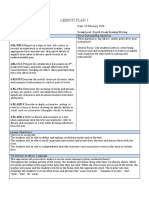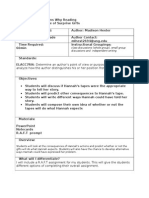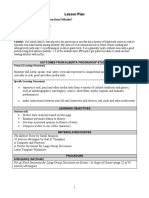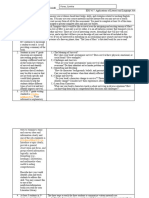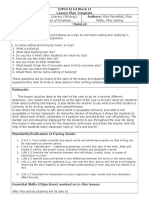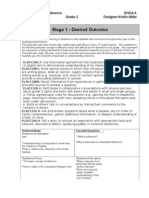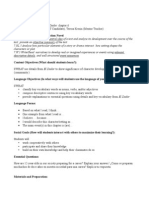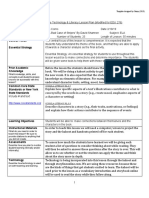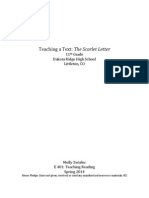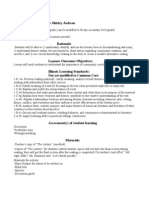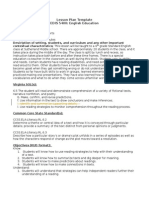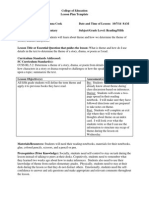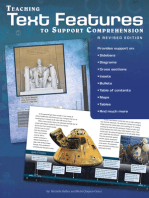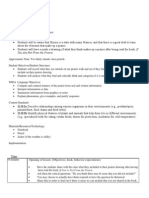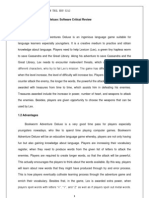Small Group Reading Lesson Plan Day 3
Small Group Reading Lesson Plan Day 3
Uploaded by
See EmpeeCopyright:
Available Formats
Small Group Reading Lesson Plan Day 3
Small Group Reading Lesson Plan Day 3
Uploaded by
See EmpeeCopyright
Available Formats
Share this document
Did you find this document useful?
Is this content inappropriate?
Copyright:
Available Formats
Small Group Reading Lesson Plan Day 3
Small Group Reading Lesson Plan Day 3
Uploaded by
See EmpeeCopyright:
Available Formats
Small Group Reading Lesson Plan Grade Level: ______3_____ Number of Students: _____6_____ Students Linguistic Backgrounds: _________English____________
Instructional Location: _Classroom___________
Length of Instruction:___20 minutes_______
Standard(s) Addressed What Common Core standards will be addressed during the lesson? Ask and answer questions to demonstrate understanding of a text, referring explicitly to the text as the basis for the answers.
Describe characters in a story (e.g., their traits, motivations, or feelings) and explain how their actions contribute to the sequence of events. 12.R.R.2 Key Ideas and Details: Determine central ideas or themes of a text and analyze their development; summarize the key supporting details and ideas.
Language Objectives
Content Objectives
Students will identify a texts theme, characters, and setting and determine how they are related while reading. independently, with partners or in a group. Students will refer to the text and use examples to support responses during discussions.
Students will describe themes, setting or situations which are not explicitly stated in the text. Students will describe the characters and setting in a story to a partner and teacher. Students will be able to articulate, in writing, summaries of what has happened at the end of each chapter and answer questions pertaining to the chapter. Students will compare and contrast, in writing, the differences of Sarah and Jacobs family and their own families/experiences.
Title: Sarah Plain and Tall Author: Patricia MacLachlan Publisher: Harper Trophy Date: 1985
Genre: Historical Fiction Text Structure: Narrative Level: 3
Theme(s) Strategy Focus New Beginnings Recognition of how important to accept new characters and setting things as they come but relate to the theme. also to hold on to sacred Would the themes found and cherished memories throughout this book be relatable to children Family many families growing up today? How are special and unique would they be different, and all can be loving. or would they at all be Abandonment the different? family fees abandoned by their mother who has died and is afraid Sarah is going to run away from them and leave like their mom.
Vocabulary Theme Setting Characters Buzzard Dune Conch Eerie Feisty Flax Gully Hearthstone Hitch Killdeer Mica Paddock Pesky Plow or plough Primly Pungent Rascal Reins Roamer Scuttling Shingles Sly Sputter Squall Squint Tumbleweed Whicker Windbreak
Assessment Informal: Are students readily able to recognize themes that are salient throughout the story? Note the students who struggle to identify theme. Asking them quick plot related questions to see if they understand the series of events Formal: Chapter questions at the end of every chapter to be answered independently accurately describing the defining traits of characters and how the characters contribute to the overall story. Evaluate the written responses to the text related to various themes - are they synthesizing all the information and understand that more is occurring than the words on the page imply? When we finish, can the students idenifty the most common theme? Writing a compare and
Wretched
contrast paragraph on Sarah versus Jacob and his family. How are they different? How are they the same?
Add any relevant information that is essential to understanding the context of your lesson:
Reflection NotesQuestions/Concerns you have after teaching the lesson(s)? Day: 3
(Make sure and write-out what you will say to your students.) Before (Introduction)
1. Say: Today we are going to continue reading. Who would like to volunteer to share with the class what happened in chapter one 2. Review what happened in chapter 1 and call on some students to make prediction on what will happen in chapter 2. 3. Today we are going to begin our lesson by going over words that were unfamiliar or interesting to us that we came across in or part of a fireplace), Horrid (foul, not pleasing), feisty (resistant, with attitude; aggressive)
* Preview the skill (Teacher led) We are going to begin chapter two today. Remember to jot down any words or phrases that may be interesting to you on your bookmark. Before we begin reading chapter two, however, we are going to review where Sarah is from and where Caleb and Anna live. * Activate and build on prior knowledge about the topic (Teacher and Students Together) Where is Maine? How far is it from the Great Plains (if we say the Great Plains are somewhere near Oklahoma, Nebraska, Kansas, and make a prediction for what is to come in chapter 2?
chapter one. We are going to use our bookmarks that we received on the first day of our reading group. Does anyone have a word they would like to share? (If students do not have a word, some we can use are hearthstones (A flat stone forming a fireplace
Illinois, or North or South Dakota). Show the students and map of the United States so they can see the distance Sarah travels. * Set a purpose We are going to begin chapter two. We want to pay attention and find out who Sarah is, and why maybe she writes everyone individually. * Introduce the focus strategy Reading and listening to each other in our small reading group. We are going to focus on why Sarah is coming to live with Anna, Caleb, and Jacob. During (Engaging in meaning making and strategy/skill practice) Asking students critical questions as we read the chapter together aloud: What do you think the biggest challenge is in moving from Maine to the Great Plains? Why does Sarah write about Maine? Do you think she will miss it? Does she seem stubborn? Is she leaving behind her old life like Anna and Calebs mother left them? After (Clarifying key concepts, extending ideas) Do you think Sarah will adapt well to life on the prairie? Write down your ideas in your literacy journal. If you were Sarah, could you adapt well in this new place? Pass out the sheet of chapter two questions and have them complete this independently before we meet again to discuss this book. Say Please use your critical thinking skills, which are located way in the back of brains, when answering chapter two questions. While it is not on the sheet of chapter two questions, I would like you to begin making predictions of what will happen next not only in chapter three, but thinking more on what will happen in the book. I am not only talking about what will happen in the end, but what events do you think will get us to the end of the book? Now when I indicate so, please quietly travel back to your desks.
Assessment:
How might you extend the lesson? Would you be scared, excited, or nervous if you were in Anna and Calebs shoes? How do they feel? Would you feel the same? Write a summary of what happened, and your prediction of what will happen. Based off of the minimal information we know about all the characters, do you think they will be a good fit as a family living together? Use sentences from the book to answer this question.
The students will be asked if they have every received something meaningful to them, such as the letter Caleb receives from Sarah. It could be a gift from a loved one, a note, or a text or email. Why are certain items so important to us? What do we know from reading and summarizing chapter one, as we did yesterday, that indicates Sarah coming to town and sending a letter is very meaningful to Caleb?
Discuss how you differentiated instruction for your learners? For students who are uncomfortable reading aloud to the class, assign them shorter passages. Prompt them with ideas and let them refer to the map when necessary to see the distance Sarah is moving. If students are unable to focus and write, have them review orally with teacher to ensure their understanding.
You might also like
- Reflective Essay LeadershipDocument7 pagesReflective Essay Leadershipapi-464152680No ratings yet
- The Tale of DespereauxDocument24 pagesThe Tale of Despereauxapi-289454387100% (1)
- Fantastic Mr. Fox UnitDocument6 pagesFantastic Mr. Fox UnitkevinzdenekNo ratings yet
- TKMB Lesson Plan Honors English IDocument89 pagesTKMB Lesson Plan Honors English Iapi-272665425100% (1)
- Ictliteracy Cum Workshop-Training MatrixDocument5 pagesIctliteracy Cum Workshop-Training MatrixJhun BautistaNo ratings yet
- LESSON PLAN Writing Water CycleDocument3 pagesLESSON PLAN Writing Water CycleMuhammad SaifullahNo ratings yet
- Childrens Lit Unit and Lesson PlansDocument18 pagesChildrens Lit Unit and Lesson Plansapi-384819868No ratings yet
- Novel Study1Document3 pagesNovel Study1api-284281839No ratings yet
- 22ticket To Curlew 22 Unit Plan - Grade 4 - Language ArtsDocument15 pages22ticket To Curlew 22 Unit Plan - Grade 4 - Language Artsapi-277527531100% (1)
- Lesson Plan 1 For ObservationDocument2 pagesLesson Plan 1 For ObservationRoopa NatarajNo ratings yet
- Lesson Plan: General Learning Outcome(s)Document6 pagesLesson Plan: General Learning Outcome(s)api-526388634No ratings yet
- LessonplanreadingDocument6 pagesLessonplanreadingapi-381663935No ratings yet
- Reading LessonDocument4 pagesReading LessonMaggie GorskaNo ratings yet
- Ma'am Geraldine Lesson PlanDocument14 pagesMa'am Geraldine Lesson PlanCutaran,brigette f.No ratings yet
- Hallmark AssignmentDocument9 pagesHallmark Assignmentapi-376753851No ratings yet
- Bands of Book Difficulty - TC HandoutDocument7 pagesBands of Book Difficulty - TC HandoutTamora Schoeneberg100% (1)
- Lesson 17Document3 pagesLesson 17api-496944127No ratings yet
- Headly El Dador 1Document4 pagesHeadly El Dador 1api-210163638No ratings yet
- Flores Ce Du 517 Final 121323Document7 pagesFlores Ce Du 517 Final 121323Cynthia Flores-LombayNo ratings yet
- Garden of KindnessDocument3 pagesGarden of Kindnessapi-354735689No ratings yet
- Teacher Guides For Books by Barbara OConnorDocument10 pagesTeacher Guides For Books by Barbara OConnorDOGObooksNo ratings yet
- Student Name: Sara Calabrese & Alba Gonzalez Grade Level: 4th Grade Guiding/Essential QuestionsDocument4 pagesStudent Name: Sara Calabrese & Alba Gonzalez Grade Level: 4th Grade Guiding/Essential Questionsapi-358268596No ratings yet
- Lesson Plan in Literature Second VersionDocument15 pagesLesson Plan in Literature Second VersionMariz CastroNo ratings yet
- Reading Mini Lesson-2-16-13Document4 pagesReading Mini Lesson-2-16-13api-217035676No ratings yet
- Rdg-Arts Unit Lesson1Document4 pagesRdg-Arts Unit Lesson1api-238738015No ratings yet
- The Scholarship Jacket Lesson PlanDocument6 pagesThe Scholarship Jacket Lesson Planapi-573197365No ratings yet
- Lesson Plan On Storytelling or Fables For First Grade ChildrenDocument3 pagesLesson Plan On Storytelling or Fables For First Grade ChildrenRaluca FilipNo ratings yet
- Sarah Plain and Tall Unit Plan OutlineDocument10 pagesSarah Plain and Tall Unit Plan Outlineapi-213200362No ratings yet
- Adapt A LessonDocument5 pagesAdapt A LessonamypeabodyNo ratings yet
- Lesson Plan Sleeping BeautyDocument3 pagesLesson Plan Sleeping Beautyapi-331810315No ratings yet
- Q2 English4 Week2Document37 pagesQ2 English4 Week2Winchez PallerNo ratings yet
- Lesson 2 ElaDocument4 pagesLesson 2 Elaapi-212739686No ratings yet
- (VCHHC068) : Finding The Main Idea of A TextDocument6 pages(VCHHC068) : Finding The Main Idea of A Textapi-263604642No ratings yet
- Kristin Miller Ubd InferenceDocument2 pagesKristin Miller Ubd Inferenceapi-176292258No ratings yet
- Formal Guided Reading-Terry Dec2013Document4 pagesFormal Guided Reading-Terry Dec2013api-198341864No ratings yet
- Lesson Plan Day 6Document4 pagesLesson Plan Day 6api-317730714No ratings yet
- Headly El Dador 6Document4 pagesHeadly El Dador 6api-210163638No ratings yet
- Lesson PlanDocument6 pagesLesson Planapi-451736723No ratings yet
- Core Lesson PlanDocument2 pagesCore Lesson Planapi-401944586No ratings yet
- Unit 5 Week 2 Benchmark Literacy Lesson Plans Compare and ContrastDocument9 pagesUnit 5 Week 2 Benchmark Literacy Lesson Plans Compare and Contrastapi-212401080No ratings yet
- Guided Reading LessonDocument16 pagesGuided Reading Lessonapi-383617357No ratings yet
- Tat Title PageDocument34 pagesTat Title Pageapi-257584473No ratings yet
- Read 436-Qri Lesson PlansDocument12 pagesRead 436-Qri Lesson Plansapi-251375394No ratings yet
- Complete Lesson Plan For The LotteryDocument11 pagesComplete Lesson Plan For The LotteryAndres Echevarria67% (3)
- Cs 424 Lesson 3Document8 pagesCs 424 Lesson 3api-582657618No ratings yet
- Lucia Jeong 3rd Observation Lesson PlanDocument7 pagesLucia Jeong 3rd Observation Lesson Planapi-235824394No ratings yet
- Children's Literature ExplorationDocument17 pagesChildren's Literature ExplorationSarah ZanNo ratings yet
- Child Soldier ResourceDocument39 pagesChild Soldier Resourcesenaial829No ratings yet
- Shelbystoudt 3330 l1Document4 pagesShelbystoudt 3330 l1api-515096468No ratings yet
- Coury Lesson Hawks On The Clock RevisedDocument3 pagesCoury Lesson Hawks On The Clock Revisedapi-312815680No ratings yet
- Tips To Teach LiteratureDocument5 pagesTips To Teach LiteraturerabailrattarNo ratings yet
- General Information: Direct Instruction 5 Grade Language Arts Lesson PlanDocument7 pagesGeneral Information: Direct Instruction 5 Grade Language Arts Lesson Planapi-611531244No ratings yet
- 5400 Lesson Plan 2 Revised Portfolio DraftDocument25 pages5400 Lesson Plan 2 Revised Portfolio Draftapi-302271477No ratings yet
- Lesson 2 Something of ValueDocument4 pagesLesson 2 Something of Valueapi-268255123No ratings yet
- Immersion Week 1 - Reading Lesson 1Document3 pagesImmersion Week 1 - Reading Lesson 1api-235237171No ratings yet
- Pde Sas Comparing Key Ideas and Details in Fiction and NonfictionDocument6 pagesPde Sas Comparing Key Ideas and Details in Fiction and Nonfictionapi-264021425No ratings yet
- Ela Mini-Lesson PlanDocument6 pagesEla Mini-Lesson Planapi-252724059No ratings yet
- The Tale of DespereauxDocument4 pagesThe Tale of DespereauxsydneyNo ratings yet
- Updated 11Document22 pagesUpdated 11api-531359184No ratings yet
- 7 Grade Diversity Lesson PlanDocument3 pages7 Grade Diversity Lesson Planapi-511543756No ratings yet
- PlannDocument6 pagesPlannCHRISTINE KARENDINo ratings yet
- Student Practice Test Booklet in Reading and Writing: Upper Elementary Grades 3-5 Comprehension and Writing Teacher to TeacherFrom EverandStudent Practice Test Booklet in Reading and Writing: Upper Elementary Grades 3-5 Comprehension and Writing Teacher to TeacherNo ratings yet
- Educator Access Plus - WA - EP - 5573 - 04.12.02.00Document1 pageEducator Access Plus - WA - EP - 5573 - 04.12.02.00See EmpeeNo ratings yet
- Student DataDocument2 pagesStudent DataSee EmpeeNo ratings yet
- Prairie Walk Lesson PlanDocument3 pagesPrairie Walk Lesson PlanSee EmpeeNo ratings yet
- Prairie Alphabet Book Lesson PlanDocument3 pagesPrairie Alphabet Book Lesson PlanSee EmpeeNo ratings yet
- Allison Maloney - ResumeDocument2 pagesAllison Maloney - Resumeapi-194210063No ratings yet
- English Curriculum: Pet BusterDocument10 pagesEnglish Curriculum: Pet BusterXije Mustafai100% (1)
- St. John Adaptive Montessori School Magsaysay, Alicia, Isabela Monthly Exam in GMRC Grade VDocument2 pagesSt. John Adaptive Montessori School Magsaysay, Alicia, Isabela Monthly Exam in GMRC Grade V渡辺正平No ratings yet
- Demonstration Teaching PlanDocument6 pagesDemonstration Teaching PlanBagwis Maya100% (2)
- FCE Formal Letter - EmailDocument7 pagesFCE Formal Letter - EmailFrancisco Javier Navas González100% (1)
- TKT Module 3Document11 pagesTKT Module 3Татьяна АндрющенкоNo ratings yet
- in Physical ScienceDocument16 pagesin Physical ScienceRiya MukherjeeNo ratings yet
- Business Math DLL Week 3 Q2Document3 pagesBusiness Math DLL Week 3 Q2Benjie Devarras100% (2)
- Vasile Conta" High School Tg. Neamţ Avizat, AvizatDocument4 pagesVasile Conta" High School Tg. Neamţ Avizat, AvizatValentina FilipNo ratings yet
- Unit 1Document17 pagesUnit 1trofinstephaneNo ratings yet
- Frog On A Lily Pad Lesson PlanDocument5 pagesFrog On A Lily Pad Lesson Planapi-290051470No ratings yet
- CL 7Document8 pagesCL 7AdtNo ratings yet
- Ae Lesson PlanDocument3 pagesAe Lesson Planapi-351067132No ratings yet
- Learning Station Day 1 Lesson PlanDocument3 pagesLearning Station Day 1 Lesson Planapi-356848727No ratings yet
- The Arts: The Ontario Curriculum Grades 1-8Document71 pagesThe Arts: The Ontario Curriculum Grades 1-8Bupavan TheeravanvilaiNo ratings yet
- Marshall Teacher RubricDocument10 pagesMarshall Teacher Rubricarnel a. amatorioNo ratings yet
- Bookworm Adventures Deluxe: Software Critical ReviewDocument4 pagesBookworm Adventures Deluxe: Software Critical ReviewAlexs NukNo ratings yet
- Issues and Answers: What's Going On in Your Association?Document5 pagesIssues and Answers: What's Going On in Your Association?api-320886833No ratings yet
- Psychological FoundationDocument26 pagesPsychological FoundationZarah Mariel Reducindo BaltazarNo ratings yet
- Career Development Program ServicesDocument14 pagesCareer Development Program Servicesalexander alobaNo ratings yet
- E-Leaqrning in Addis Ababa UnivesityDocument37 pagesE-Leaqrning in Addis Ababa Univesityfeleke20140% (1)
- Lesson Plan English Year 4Document4 pagesLesson Plan English Year 4Nurul HusnaNo ratings yet
- Slac Narrative Report JanuaryDocument3 pagesSlac Narrative Report JanuaryLovelle Angel MontejoNo ratings yet
- A Socio Cultural Perspective On School Based Literacy Research Some Emerging ConsiderationsDocument18 pagesA Socio Cultural Perspective On School Based Literacy Research Some Emerging ConsiderationsNathalia ChávezNo ratings yet
- ISE 1 (B1) Interview - Lesson Plan 6 - Using Trinity DVDs For Preparation (Final)Document4 pagesISE 1 (B1) Interview - Lesson Plan 6 - Using Trinity DVDs For Preparation (Final)iSVilaNo ratings yet
- Field Study 4 Exploring The CurriculumDocument34 pagesField Study 4 Exploring The CurriculumJerick Mangiduyos LapurgaNo ratings yet
- Running Head: Customized Learning Theory Paper 1Document9 pagesRunning Head: Customized Learning Theory Paper 1Matt McCuneNo ratings yet






